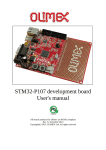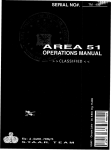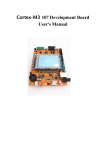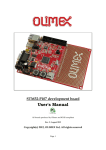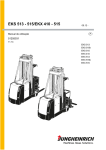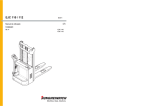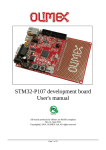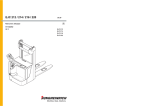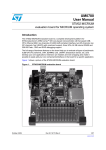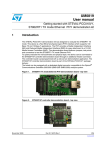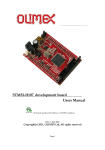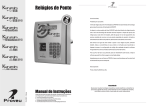Download STM32-P107 development board User`s manual
Transcript
STM32-P107 development board User's manual All boards produced by Olimex are ROHS compliant Rev. G, December 2013 Copyright(c) 2013, OLIMEX Ltd, All rights reserved DISCLAIMER © 2013 Olimex Ltd. Olimex®, logo and combinations thereof, are registered trademarks of Olimex Ltd. Other product names may be trademarks of others and the rights belong to their respective owners. The information in this document is provided in connection with Olimex products. No license, express or implied or otherwise, to any intellectual property right is granted by this document or in connection with the sale of Olimex products. This hardware design of STM32-P107 is neither public not open-source. Any copying of the product would result in copyright infringement. The software is released under open source terms regarding the code written by Olimex. Every other else (libraries, ready-to-use-files, etc) follow their owner's copyright. It is possible that the pictures in this manual differ from the latest revision of the board. The product described in this document is subject to continuous development and improvements. All particulars of the product and its use contained in this document are given by OLIMEX in good faith. However all warranties implied or expressed including but not limited to implied warranties of merchantability or fitness for purpose are excluded. This document is intended only to assist the reader in the use of the product. OLIMEX Ltd. shall not be liable for any loss or damage arising from the use of any information in this document or any error or omission in such information or any incorrect use of the product. This evaluation board/kit is intended for use for engineering development, demonstration, or evaluation purposes only and is not considered by OLIMEX to be a finished end-product fit for general consumer use. Persons handling the product must have electronics training and observe good engineering practice standards. As such, the goods being provided are not intended to be complete in terms of required design-, marketing-, and/or manufacturing-related protective considerations, including product safety and environmental measures typically found in end products that incorporate such semiconductor components or circuit boards. Olimex currently deals with a variety of customers for products, and therefore our arrangement with the user is not exclusive. Olimex assumes no liability for applications assistance, customer product design, software performance, or infringement of patents or services described herein. THERE IS NO WARRANTY FOR THE DESIGN MATERIALS AND THE COMPONENTS USED TO CREATE STM32-P107. THEY ARE CONSIDERED SUITABLE ONLY FOR STM32-P107. Page 2 of 19 INTRODUCTION STM32-P107 prototype board provides easy way for developing and prototyping with the new STM32F107VCT6 connectivity line microcontroller, produced by STMicroelectronics. STM32P107 has JTAG port for programming and debugging, USB_OTG, user button, two status LEDs, and most of the GPIOs are on extension headers where you can connect your additional circuits. BOARD FEATURES - CPU: STM32F107VCT6 32 bit ARM-based microcontroller with 256 KB Flash, 64 KB RAM, USB OTG, Ethernet, 10 timers, 2 CANs, 2 ADCs, 14 communication interfaces - JTAG connector with ARM 2x10 pin layout for programming/debugging - USB_OTG connector - USB_HOST connector - 100Mbit Ethernet - RS232 - Mini SD/MMC card connector - UEXT connector - Power jack - Two user buttons - RESET button and circuit - Two status LEDs - Power-on LED - 3V battery connector - Extension port connectors for many of microcontrollers pins - PCB: FR-4, 1.5 mm (0,062"), soldermask, silkscreen component print - Dimensions: 132.08x96.52mm (5.2x3.8") ELECTROSTATIC WARNING The STM32-P107 board is shipped in protective anti-static packaging. The board must not be subject to high electrostatic potentials. General practice for working with static sensitive devices should be applied when working with this board. Page 3 of 19 BOARD USE REQUIREMENTS Cables: The cable you will need depends on the programmer/debugger you use. If you use ARMJTAG, you will need LPT cable, if you use ARM-USB-OCD, ARM-USB-OCD-H, ARM-USBTINY, or ARM-USB-TINY-H you will need 1.8 meter USB A-B cable, for ARM-USB-OCD and ARM-USB-OCD-H you will need RS232 cable, too. Hardware: Programmer/Debugger – one of the Olimex ARM Programmers: ARM-JTAG, ARMJTAG-EW, ARM-USB-OCD, ARM-USB-OCD-H, ARM-USB-OCD-TINY, ARM-USB-OCD-H. Note that Olimex OpenOCD debuggers lack SWD interface by default. There is the adapter ARMJTAG-SWD that adds SWD to any of the programmers/debuggers mentioned above. Additionally you can use our ARM-JTAG-COOCOX debugger which has both JTAG and SWD interfaces and works with CooCox IDE natively and with IAR EW and Keil uVision via pluggins. Software: ARM C compiler PROCESSOR FEATURES STM32-P107 board uses the ARM-based 32-bit microcontroller STM32F107VCT6 with the following features: – Core: ARM 32-bit Cortex™-M3 CPU – 72 MHz maximum frequency, 1.25 DMIPS/MHz (Dhrystone 2.1) performance at 0 wait state memory access – Single-cycle multiplication and hardware division – Memories – 256 Kbytes of Flash memory – 64 Kbytes of SRAM – Clock, reset and supply management – 2.0 to 3.6 V application supply and I/Os – POR, PDR, and programmable voltage detector (PVD) – 25 MHz crystal oscillator – Internal 8 MHz factory-trimmed RC – Internal 40 kHz RC with calibration – 32 kHz oscillator for RTC with calibration – Low power – Sleep, Stop and Standby modes – VBAT supply for RTC and backup registers – 2 × 12-bit, 1 µs A/D converters (16 channels) – Conversion range: 0 to 3.6 V – Sample and hold capability – Temperature sensor – up to 2 MSps in interleaved mode – 2 × 12-bit D/A converters – DMA: 12-channel DMA controller – Supported peripherals: timers, ADCs, DAC, I2Ss, SPIs, I2Cs and USARTs Page 4 of 19 – Debug mode – Serial wire debug (SWD) & JTAG interfaces – Cortex-M3 Embedded Trace Macrocell™ – 80 fast I/O ports – 80 I/Os, all mappable on 16 external interrupt vectors and almost all 5 V-tolerant – 10 timers – four 16-bit timers, each with up to 4 IC/OC/PWM or pulse counter and quadrature (incremental) encoder input – 1 × 16-bit motor control PWM timer with dead-time generation and emergency stop – 2 × watchdog timers (Independent and Window) – SysTick timer: a 24-bit downcounter – 2 × 16-bit basic timers to drive the DAC – 14 communication interfaces – 2 × I2C interfaces (SMBus/PMBus) – 5 USARTs (ISO 7816 interface, LIN, IrDA capability, modem control) – 3 SPIs (18 Mbit/s), 2 with a multiplexed I2S interface that offers audio class accuracy via advanced PLL schemes – 2 × CAN interfaces (2.0B Active) with 512 bytes of dedicated SRAM – USB 2.0 full-speed device/host/OTG controller with on-chip PHY that supports HNP/SRP/ID with 1.25 Kbytes of dedicated SRAM – 10/100 Ethernet MAC with dedicated DMA and SRAM (4 Kbytes): IEEE1588 hardware support, MII/RMII available on all packages – CRC calculation unit, 96-bit unique ID Page 5 of 19 Page 6 of 19 Page 7 of 19 SCHEMATIC STM32-P107, board revision C 3 3V OLIMEX LTD, PLOVDIV, BULGARIA 2013 VBA 94 3 3V BOO 0 12 OSC_IN 0 0 9 R16 RS NA 0 13 15 RS C2 C3 C 8 OSC32_ N C 95 OSC32_OU NC 97 E1 1 E2 RACECK 2 E4 RACED1 E5 RACED2 5 E7 IM1_E R 39 E9 IM1_CH1 41 42 E11 IM1_CH2 43 E13 IM1_CH3 45 D 61 4 M4_CH3 H _SO D 62 5 M4_CH4 E14 IM1_CH4 46 E15 IM1_BKIN RM1G3 _RS C21 10p RS C23 10p RM2G1 RA1206_ 4x0603 _4B8_10k RM2G3 5V_J AG RM2G4 1 2 2 1 E H_RMII_MD N E H_RMI _MD N E H_RMII_ XD0 E H_RMII_ XD1 E H_RMI _ XD0 E H_RMI _ XD1 R20 R21 5 E H_RMI _ X_EN E H_RMII_RXD0 E H_RMII_RXD1 E H_RMI _RXD0 E H_RMI _RXD1 1N 10 R39 330R RM3G1 0 0 0 0 0 0 HN1x2 Open) R40 330R D3 R1IN R1OU 3 3V 16 8 V 16 17 18 XD1 24 XD2 25 XD3 21 XEN 19 20 6 3 7 4 8 5 9 100n 10uC7 100nC 0 0 0 0 R29 R28 100n24 1 VDD2A XER XD4 9 RXD2 RM ISE 8 RXD3 H AD2 6 VDDCR 00 100 1 3 2 14 CRS 2 ED2 N 3 ED1 R AG KG A 29 K 28 XN 31 7 30 RXN 8 X NRS 6 RX 32 RB AS 1 AN8710A-EZC 1 4 5 2 D COM DAG KG A Y W K RD NC RD- V RJ BC 060 C1 C37 R33 549R 1%100n E H_RMI_RE _C K R38 33k R37 CD1 4 VDD ED 3 3V 1 3 3V 3 3V UEXT 3 2 VSS OU 0 0 3 3V 0 0 0 0 0 0 0 0 0 0 M B G4 M B G3 MB G1 R43 4 7k H AD0 H AD1 H AD2 RM ISE UEX _ WR_E C OSE USAR 3_ X I2C1_SC S 3_MISO S 3_SCK UEX 1 2 3 4 5 6 7 8 9 USAR 3_RX I2C1_SDA S 3_MOSI CS_UEX 10 BH10S 5V 3 3V 3 3VA R46 5V 3 3V 3 3VA S 3_SCK S 3_MOSI S I3_MISO CS_UEX I2C1_SC 2C1_SDA USAR 3_ X USAR 3_RX S I1_NSS S I1_SCK S I1_MISO S I1_MOSI USAR 2_ X USAR 2_RX USAR 2_R S USAR 2_C S 2 2k WR_ ED 1N5819S VO 2 D6 5V_EX 1N5819S N GND_ 2 2 C OSE R51 2 2k C42 R52 2 2k 2 VCC RESE R53 1 3 V GND S A 1 R54 100R 1% S A 2 GNDA_E 1 2 AGND 1 B1_0 B1_1 RS HN1x3 330R GND 100n C53 0 R55 300R 1% 6 3V 2 2u C41 22uC4 100n 4 22uC4 22uC4 R56 R47 B2 BOO 1 10k R48 10k U6 NA S M1001RWX6 ) 0 V 0 C52 RESET CIRCUIT 0 R50 22uC4 C40 470u 16VDC 1 OU ADJ GND R49 100R 1% 100n C44 1 GND ADJ C43 100n 3 3V S A 2 S A 1 3 3VA_E 22uC5 VI VR2(3 3V) M1117IM X-ADJ 22uC5 3 D -1136 6VAC (6 5 9)VDC 3 3V C OSE 1 VR1(5 0V) AME1085 0 WR_JACK STATUS LEDS 0 0 Y W0 0 RESE STM32-P107, board revision C C54 OLIMEX LTD, PLOVDIV, BULGARIA 2013 100n https: /www.olimex com 90 C OSE 3 D5 3 3V_E 2 5V_O G_ WR ED RED 0603 1 1N5819S G1 0 D4 3 7 8 6 WKU R41 33k NA 6NC2-50MHz) 5V_J AG GN GN 9 0 AN E H_RM I_RE _C K 5 X A 1 C KIN B 19 0 4 X A 2 B NA 10k 3 3V 5 00 GND 15 CO CRS_DV MODE2 R31 C39 100n POWER SUPPLY C RCUIT USB 0 3 3V 330R NA R15 R17 R18 4 B0 0 17 MDC 16 MDIO E H_RMII_RE _C K 100n R42 33k 33k 33k C2022u 6 3V 27 VDD1A 26 RXDV 7 RXC K H AD1 13 RXER RXD4 H AD0 RM3G3 E H_RMI _CRS_DV H _SO _RS R35 100R 1% C38 5 R12 R13 AM ER R36 100R 1% AM ER 3 3V 1M 10k Ethernet 12 VDDIO XC K 18 N N C5510u 6 3V 330R 2 9 0 S 3_SCK S 3_MISS 3_MISO MICRO RM3G4 0 0 D C114 KA D 1N41 12 14 15 C35 1 U5 WR 1N4148 10 11 13 11 RXD0 MODE0 10 RXD1 MODE1 B E H_RMI _MDC E H_RMI _MD O 3 3V 100n C_ XD C_C S 3 R2IN R2OU 8 9 XD0 23 20 B 0 2 R34 0 SD/MMC U4 RMI SE H AD2 E H_RMII_CRS_DV H _SO _RS RS1 C_DCD C_RXD C_R S 4 2OU 7 2N 12 9 2 1 BOO 0 1OU 7 RM3G2 E H_RMII_MD O R30 10k 4 6 WKU C2- 11 BOO 0_E 6 C2 100n USAR 2_RX USAR 2_C S 100n C34 100n 3 3 3V 2 2k 330R 22 E H_RMII_ X_EN 0 4 C33 2 V- 00 C2222u 6 3V 3 3V R32 C36 V C1- 2 2k C1 D ID GND 00 BH20S 3 3V U5 S 3232BDR(SO16) D- 3 CS_MMCCS_MMC S 3_MOSI S 3_MOSI 2 CD DA 3 CMD D 6 VSS 4 VDD 5 C K SC K 7 DA 0 DO 8 DA 1 RES 1 DA 2 R 2 5 O EN E H_RMII_MDC USAR 2_ X USAR 2_R S 100n GND4 2 2k RM1G1 HN1x2(Open) 3 3V 3 33k J AG RA1206_( x0603)_4B8_ 0k 3 3V BUTTONS RS _E RS 1 C16 2 2u 6 3V SD MMC NA H AD1 H AD0 C32 100n C15 3 3V R11 S M32 107VC 6 RS232 USB 3 2 1 RM1G4 1 DO RS D10 D11 D12 D13 D14 D15 D 59 2 M4_CH1 USAR 3_R S E H_M I_RX_D3 D 60 3 M4_CH2 E12 IM1_CH3N 44 E H_RMII_MD N USB_ AU RM1G2 USAR 3_ X USAR 3_RX D 57USAR 3_CK E H_M I_RX_D1 D 58USAR 3_C S E H_M I_RX_D2 E10 IM1_CH2N RM2G2 JTAG S I3_SCK S I3_M SO S I3_MOSI USAR 2_C S USAR 2_R S USAR 2_ X USAR 2_RX D6 D7 D 55SAR 3_ XUSARM 3_R X_DV D 56SAR 3_RXUSAR _M3_RX X D0 E8 IM1_CH1N 40 VBUS M CRO_AB R- D1 D2 D3 D4 D5 D 87SAR 2_RXUSAR 2_RX D 88SAR 2_CKUSB_VBUSON E6 RACED3 38 USB_O G 5V_O G_ WR USB_O G_DUSB_O G_D O G_ID USB_O G_DUSB_O G_D 0 0 RS DI MS CK Q2 32768Hz D384 USAR 2_C USAR S 2_C S D485 USAR 2_R USAR S 2_R S D 86SAR 2_ XUSAR 2_ X E3 RACED0 3 4 E H_RMII_MDC C8 C9 C10 C11 D081 OSC_IN CAN1_RX D182 OSC_OU CAN1_ X D283 M _E R UAR 5_RX E0 IM4_E R 98 USB_OTG 5V_O G_ WR USB_HOS _DUSB_O G_D- 100n E H_RMII_RXD0 E H_RMII_RXD1 R1 NA E1 E2 E3 E4 E5 E6 E7 E8 E9 E10 E11 E12 E13 E14 3 3V CS_UEX C4 C5 C6 C7 C 80UAR 5_ XS SI3_MOSI S I3_MOSI C 7 AM ER-R AM ER NRS 73 C1 C217 ADC12_IN12 E H_MI _ XD2 C318 ADC12_IN13 E H_MI _ X_C K C433 ADC12_IN14 H_MI _RXD0 E H_RMI _RXD0 E EH_RMII_RXD0 C 66 M _CH4 C 78UAR 4_ XS SI3_SCK S I _SCK C 79UAR 4_RXS I3_M SO X S I3_MISO OSC_OU 14 33k O G_ID 2C1_SC 2C1_SDA B11 M _CH3N C 15DC12_IN10 C116 ADC12_IN11 H_MI _MDC E H_RM I_MDC E EH_RMII_MDC C7642S3_MCK SMA_C2 2 C 65 M _CH3 R14 Q1 C19 27p H B9 C534 ADC12_IN15 H_MI _RXD1 E H_RMI _RXD1 E EH_RMII_RXD1 C6632S2_MCK SMA_C1 1 B0_0 B0_1 C18 27p O 22uC26 3 2 1 1 R6 USB_DHN1x3(O Close H Open) B RJ45 S DE R10 10k N1x3 0 3 GND2 BA 54C 1 2 6 2 4 22uC26 3V BOO 0 1 5 R27 B154S 2_MOSCS_UEX _ D1 3V_BA W 2S 6 C13 B148 2C2_SDAE SH_RMII_ 3 E X_EN M _ X_EN E H_RM I_ X_EN IM2_CH4 E H_RMII_ X_EN B151S 2_NSSE SH_RMII_ W 2XD0 M A USAR 3_CK M _BK N CAN2_RX E H_M I EX H_RMII_M XD0D0 B152S 2_SCKE SH_RMII_ RXD1 _ S M1 CH1N CAN2_ X E H_MI _ XD1 E H_ E MI H_RMII_ D XD1 B153S 2_MISO M1_CH N USAR 3_R S VRE VBA 3 3V 3 USB_A 9 0 0 R9 0R 0 B996 M4_CH4 22C1_SDA _ AN1_ X B1472C2_SC USAR 3_ X E H_M I_RX_ER IM2_CH3 VRE - R7 C12 NA(47p ) NA(47 ) IM3_CH2 S 1_MOSI CAN2_RX B6 B7 B7932C1_SDA M4_CH2 USAR _RX B895M4_CH3 E2C1_SC H_MI _ XD3 2C1_SC CAN1_RX VRE 20 R3 22R 0 B NA 22R 00 0 21 100n C17 C11 2 22R C14 O G_DM DO RS B490 JN RS S I3_MISO IM3_CH1 S 1_MISO RS B5912C1_SMBA S I3_MOSI E H_M I_ S_OU E H_RM I_ S_OU B5 B6922C1_SC M _CH1 USAR 1_ X CAN2_ X VRE R8 B1 B2 B3 B035DC12_ N8 M3 CH3 E H_MI _RXD2 IM1_CH2N B136DC12_ N9 M3 CH4 E H_MI _RXD3 IM1_CH3N B237OO 1 B2 BOO 1 B389 J DO S 3_SCK DO RACESWO M2_CH2 S I1 SCK VSSA 00 GND3 O G_D VDDA 19 0 0 M C2026-1 M 1 C10 100n GND6 OU 5 B AG_B 22uC26 3V C9 10u 6 3 AG_A ENB R22 49 9R 1% R23 49 9R 1% R24 49 9R 1% R25 49 9R 1% 549R 1%R 22 9 0 U2 100n28 0 4 OU 8_A IN 7 ENA 3 USB_ AU R5 0 1 USB_VBUSON USB_HOS _D USB_O G_D 5V U3 2 H 3 3V 100n27 00 MS CK DI C30 2 0 0 HN1 3 O C ose H Open) O A172J MS SWDIMS A176J CK SWC CK A177J DI S 3_NSS M2 CH1_E R S I1_NSS VSS 1 D A 14 KA 3 3V C31 2 2u 6 3V 2 VSS 49 USB_D A11 CAN1_RX IM1_CH4 O G_ S_DM 70USAR 1_COS G_DM A171USAR 1_ROS G_D1_ X M1_E R O G_ S_D VSS 74 2 4 M _CH E N H RM I_CRS_DV R4 VSS 99 1 1 A968 USAR 1_ XO IM1_CH2 O G_ S_VBUS G_VBUS A10 IM1_CH3 O G_ S_ D O G_ID 69USAR 1_RX VSS 27 1 3 3VA_MCU_E C OSE 10 5V_HOS _ WR USB_HOS _DUSB_HOS _D A5 A732 S 1_MOSI E ADC12_IN7 M3_CH2 E H_M I RX_DV E H_RM I_CRS DV H_RMII_CRS_DV A867 USAR 1_CK O G_ S_SO M1_CH1 MCO R2 22R 3 3VA USB_HOS 5V_HOS _ WR USB_HOS _DUSB_HOS _D GND1 A530 S 1_SCK DAC_OU 2 ADC1 _IN5 A631 S 1_M SO ADC12_IN6 M3_CH1 IM1_BK N 3 VDD 2 VDD 5V_HOS _ WR 5V_O G_ WR 0R Boa d_Mounted) A225SAR 2_ XE I H_RMII_MD C 1O _ N2 M2_CH3 E H_MI _MD O E H_ MI MD O E H_RMII_MD O A326SAR 2_RX IM5_CH4 ADC12_ N3 M2 CH4 E H_MI _CO A3 A429 1_NSS DCS_MMCUSAR 2_CK ADC12_ 4 CS_MMC VDD 100n C5 100n C4 4 7u 6 3V C3 28 11 USB_HOST H 0 1 100 VDD R1 O G_VBUS 3 VDD 75 100n C2 A023 KU USAWKU _ S ADC 2_IN0 IM2_CH1_E R IM5_CH1 E H_M I_C S_WKU A124SAR 2_R E AH_RMII_RE 1 M5_C HK M _CH2 E H_MI _RX_C K E H_ MI REE CH_RMII_RE _C K 2 50 100n C1 O U1 1 1 2 C OSE USB CIRCUIT VBUS HN1x3(O C ose H Open) https: /www.o imex com 3 3V_MCU_E R44 R45 4 7k 33k 0 0 0 BOARD LAYOUT POWER SUPPLY CIRCUIT STM32-P107 can take power from three sources: – PWR connector where (6.5-9)V DC or 6V AC is applied by external power source. – +5V_ OTG-PWR from USB OTG – +5V_JTAG from JTAG The programmed board power consumption is about 70 mA. RESET CIRCUIT STM32-P107 reset circuit includes JTAG connector pin 15, U2 (STE101P) pin 28 (RESET), R73(10k), R74(330Ohm), R75(100Ohm/1%), C55(100nF), STM32F107 pin 14 (NRST) and RESET button. CLOCK CIRCUIT Quartz crystal 25 MHz is connected to STM32F107 pin 12 (OSC_IN) and pin 13 (OSC_OUT). Quartz crystal 32.768kHz is connected to STM32F107 pin 8 (PC14/OSC32_IN) and pin 9 (PC15/OSC32_OUT). JUMPER DESCRIPTION PWR_SEL When position 1-2 is shorted – the board is power supplied from JTAG. When position 3-4 is shorted – the board is power supplied from USB_OTG. When position 5-6 is shorted – the board is power supplied from External source. Default state is – position 5-6 – shorted. B0_0/B0_1 When this jumper is in position B0_1 – BOOT0 is connected to 3.3V, and jumper is in position B0_0 – BOOT0 is connected to GND. Default state is B0_0. B1_0/B1_1 When this jumper is in position B1_1 – BOOT1 is connected to 3.3V, and jumper is in position B1_0 – BOOT1 is connected to GND. Default state is B1_0. power when the when the VBUS When is in position “H” - connects +5V_HOST_PWR to OTG_VBUS. When is in position “O” - connects +5V_OTG_PWR to OTG_VBUS. Default state is “O”. USB_D+ When is in position “H” - connects USB_HOST_D+ to OTG_DP. When is in position “O” - connects USB_OTG_D+ to OTG_DP. Default state is “O”. USB_DWhen is in position “H” - connects USD_HOST_D- to OTG_DM. When is in position “O” - connects USB_OTG_D- to OTG_DM. Default state is “O”. PWDW_D When is closed – disables Ethernet transceiver (STE101P) Power Down Mode. STE101P is active. Default state is closed. 3.3V_MCU_E Enable microcontroller 3.3V power supply Default state is closed. 3.3V_E Enable regulator VR2 (3.3V) - LM1117 Default state is closed. 3.3VA_E Enables board 3.3V analog power supply. Default state is closed. 3.3VA_MCU_E Enables microcontroller 3.3V analog power supply. Default state is closed. GNDA_E Enables board analog GND. Default state is closed. R-T Connects RST to TRST Default state is open. RST_E, BOOT_E jumpers Note that it is recommended to move those jumpers together – either both open or both should be closed. When both are closed RS232 boot is enabled. Default states are RST E – open; BOOT E – open. INPUT/OUTPUT Status LED1 (green) with name STAT1 connected to STM32F107 pin 63 (PC6/I2S2_MCK/TIM3_CH1). Status LED2 (yellow) with name STAT2 connected to STM32F107 pin 64 (PC7/I2S3_MCK/TIM3_CH2). Power-on LED (red) with name PWR – this led shows that +3.3V is applied to the board. User button with name WKUP connected to STM32F107 pin 23 (PA0/WKUP). User button with name TAMPER connected to STM32F107 pin 7 (PC13/TAMPER-RTC). Reset button with name RESET connected to STM32F107 pin 14 (NRST). should be CONNECTOR DESCRIPTIONS JTAG The JTAG connector allows the software debugger to talk via a JTAG (Joint Test Action Group) port directly to the core. Instructions may be inserted and executed by the core thus allowing STM32F107 memory to be programmed with code and executed step by step by the host software. For more details please refer to IEEE Standard 1149.1 - 1990 Standard Test Access Port and Boundary Scan Architecture and STM32F107 datasheets and users manual. Pin # Signal name Pin # Signal name 1 3.3V 2 3.3V 3 TRST 4 GND 5 TDI 6 GND 7 TMS 8 GND 9 TCK 10 GND 11 PULL-DOWN 12 GND 13 TDO 14 GND 15 RST 16 GND 17 PULL-DOWN 18 GND 19 +5V_JTAG 20 GND PWR_JACK Pin # Signal name 1 Power input 2 GND USB_HOST Pin # Signal name 1 +5V_HOST_PWR 2 USB_HOST_D- 3 USB_HOST_D+ 4 GND USB_OTG Pin # Signal name 1 +5V_OTG_PWR 2 USB_OTG_D- 3 USB_OTG_D+ 4 OTG_ID 5 GND 3V_BAT Pin # Signal name 1 VBAT 2 GND RS232 The RS232 port can be used for communication when in bootloader mode. To enter bootloader mode you need to close RST_E and BOOT0_E jumpers. Note that the default position of those jumpers is closed, e.g. bootloader mode disabled. Pin # Signal name 1 NC 2 T1OUT 3 R1IN 4 NC 5 GND 6 NC 7 CTS 8 RTS 9 NC UEXT Pin # Signal name 1 3.3V 2 GND 3 USART2_TX 4 USART2_RX 5 I2C1_SCL 6 I2C1_SDA 7 SPI3_MISO 8 SPI3_MOSI 9 SPI3_SCK 10 CS_UEXT LAN Pin # Signal name chip side Pin # Signal name chip side 1 TX+ 5 Not connected (NC) 2 TX- 6 VDD 3 VDD 7 RX+ 4 Not connected (NC) 8 RX- LED Color Usage Right Green Link status Left Yellow Activity status SD/MMC Pin # Signal name 1 2 3 4 5 6 7 8 9 10 11 12 MCIDAT2 CS_MMC SPI3_MOSI 3.3V SPI3_SCK GND SPI3_MISO MCIDAT1 Not connected Not connected Not connected Not connected MECHANICAL DIMENSIONS All measures are in mils. AVAILABLE DEMO SOFTWARE All demo examples are available at the board's web-page (https://www.olimex.com/Products/ARM/ST/STM32-P107/) and wiki article (https://www.olimex.com/wiki/STM32-P107). Make sure that the demo you download is compatible with the board revision you have! The board revision is printed on STM32-P107 itself. REVISION AND ORDERING INFORMATION STM32-P107 – fully assembled and tested Manual revision history: REV. I REV. A REV. B REV. C REV. D REV. E REV. F REV.G - created December 2009 - edited by TU December 2010 - demo software added and mechanical dimensions detaile - rev. A schematic and added more programmers in BOARD USE REQUIREMENTS. - edited June 2011 – changed schematic - changed schematics to rev. B, added board revision history - added BOOT0_E, RST_E description, changed dimensions, updated revision B pictures, updated disclaimer - updated the information to fit board revision C, updated schematics, improved document layout, added product support information, updated links Board revision history: rev. A ======== 1. ST2052BD is exchanged with LM3526-L. 2. SD/MMC signals are changed as follows: SPI1_MOSI -> SPI3_MOSI SPI1_SCK -> SPI3_SCK SPI1_MISO -> SPI3_MISO and SPI1_NSS renamed to CS_MMC 3. Changed the polarity to + of C36 rev. B ======== 1. All element libraries are now updated 2. Ethernet PHY is changed from STE101P to MICREL's one - KS8721BLMM 3. All 10uF/6.3V/TANT are changed to 0805 and a lot of element names are changed. 4. PWR_SEL jumpers are replaced by diodes. 5. USART3 is connected to UEXT while USART2 is connected to RS232 and bootloader functionality is enabled! Two additional jumpers are added!!! 6. Added UEXT_PWR_E jumper! 7. A lot jumpers are added into jumpers description table rev. C ======== 1. L2 is now placed further from USB_HOST connector to avoid contact 2. Ethernet PHY Micrel KS8721 is changed to LAN8710A-EZC in RMII 3. Changed C18 from 100n to 4.7uF/6.3V according to the datasheet. C18 is now renamed C3. 4. STAT1, STAT2 and PWR_LED were changed to 0603 and its resistors to 2.2k. 5. SD/MMC capacitor was replaced by 2x22uF/6.3V capacitors. 6. LM3526 was exchanged with MIC2026-1YM and connection between pin 1 and pin4 was swapped because the default EN level is opposite. 7. All tantalum capacitors are changed to ceramic. 8. Optimizations in the values of few other elements as well. 9. R28(0R) was changed to 10k, C55=10uF/6.3V was added and RST connection was removed from the PHY!



















